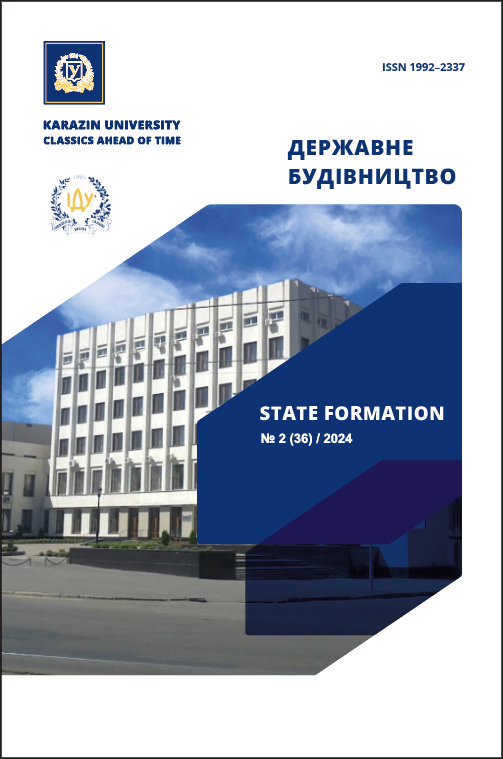Public management in the field of health care as a structural and functional means of improving the quality of life of citizens.
Abstract
Within the scope of this article, public management in the field of health care was investigated as a structural and functional means of improving the quality of life of citizens, which allowed to identify the purpose of state institutions to increase the efficiency of the provision of medical services and ensure the necessary guarantees of social security of the population, which together form a certain institutional maximum to ensure controllability of relevant processes in the field of providing medical services and improving the quality of the population’s health. The development of national health care systems is identified, which is determined by the criterion of strengthening the state’s social security indicators, the effectiveness of its participation in the processes of expanding social guarantees to the population. The expediency of introducing an integrated indicator of determining the institutional capacity of the state to improve the quality of life of the population is substantiated, in accordance with which a modernization and reform toolkit for the transformation of the public administration system in the field of health care is proposed, by bringing it into maximum compliance with the expectations and demands of the population in the form of building an integrated system public management in the field of health care, as a condition for guaranteeing the effectiveness of institutional changes in the field of health care and restraining the negative dynamics associated with the decline in the quality of medical care and the quality of life of the population in general.
Public administration in the field of health care has been identified as a structural condition for ensuring the social security of the state in the postmodern period in the form of providing institutional guarantees for the realization of the rights of citizens to receive quality medical care, improving the quality of life of the population, improving the demographic situation, employment and social security, the effectiveness of overcoming relevant social anomalies characteristic of the development of the welfare state as an indicator of the state’s ability to respond appropriately to ensuring the anthropocentric value of its public policy; it was established that the strategic priority for national systems of public administration in the field of health care in the postmodern period is the introduction of complex systems of strategic planning in the field of social security of the population, aimed at ensuring high indicators of the quality of life of the population by organizing the interaction of institutions of the state, society and business, forming of the latest network determination between them regarding the coordination of efforts in the context of ensuring the effectiveness of the quality of life of the population
Downloads
References
Grishin, V. V. (2018). Reform of a national health care system. Health care. 4. 139–144.
Speller, V. (2013). Principles and Practice of Health Promotion. Health Promotion and Healthy Public Policy. 3. 356–379.
Hernandez-Quevedo, C., Llano, R. & Mossialos, E. (2013). Paying for integrated care: An Overview. Eurohealth. 19. 2. 3–6.
The World Bank Indicators. URL: http://data.worldbank.org/indicator
Health at a Glance: Europe 2016 (2017). State of Health in the EU Cycle. OECD, EUROSTAT, European Ec Commission.
Berman, B. W. (2014). The Generalist-Specialist Interface: Not a Zero-Sum Game. Clin Pediatr (Phila), 53, 719–720.
National Healthcare Quality Report 2013 (2014). U.S. Department of health and human services. AHRQ Publication. 14-0005. May. URL: www.ahrq.gov/research/findings/nhqrdr/
index.html
The World Bank. Health expenditure per capita (current US$). URL: http://data.worldbank.org/indicator/SH.XPD.PCAP
Gottret, P. & Schieber, G. (2016). Health financing revisited: a practitioner’s guide. World Bank. URL: http://siteresources.worldbank.org/INTHSD/Resources/topics/Health-Financing/HFRFull.pdf
Clements, B., Coady, D., Shang, B. & Tyson, J. (2021). Healing Health Care Finances. Finance & Development, 48, 1, 42–45.
Borger, С., Smith, S., Truffer, C., Keehan, S., Sisko, A., Poisal, J. & Kent V. C. Health Spending Projections Through. 2015. 489 р.
The Most Efficient Health Care: Countries (2014). URL: http://www.bloomberg.com/
visual-data/best-and-worst/most-efficient-health-care-2014-countries
The World Health Report 2000 (2000). Health Systems: Improving Performance. World Health Organization WHO. 215.
Bloom, D. & Canning, D. (2020). The Health and Wealth of Nations. Science, 287(5456), 1207–1209.
Wilson, A. (2021). Virtual politics: faking demoacy in the Post-Soviet world. Yale University Press, 478.

